2.
GHANA
CSRD to log submerged hardwoods
It is estimated that the Volta Lake reservoir holds timber
resources worth US$2.8 billion. The Volta River Authority
and the government of Ghana signed an agreement with
Clark Sustainable Resource Developments Ltd. (CSRD)
for logging, processing and marketing of this underwater
timber.
Harvesting is about to start as a 400,000 pounds SHARC
harvester has been brought in and will now undergo
testing.
The project will secure legally certified timber products
from Ghana for international markets.
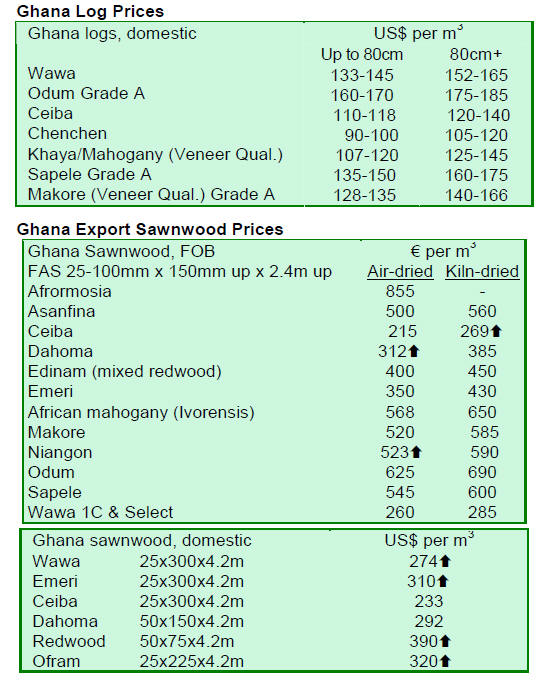
3.
MALAYSIA
Higher shipping rates concern exporters
Exporters of timber and timber products in Malaysia have
expressed concern over rising prices of crude oil and the
effect on freight rates. Shipping costs to destinations such
as Europe and North America have been rising. According
to exporters, any further increases freight rates may result
in significant timber price increases and a loss of
competitiveness.
MTIB monitoring the impact of anti-dumping tariff
The Malaysian Timber Industry Board (MTIB) will be
monitoring the timber trade between Malaysia and South
Korea for the next few months following the imposition by
South Korea of anti-dumping duties.
The MTIB calculates that the Korean government has
imposed an average 10% import tariff on Malaysian
plywood.
South Korea was one of the biggest markets last year for
Malaysian timber products such as veneer, plywood and
sawn timber and in 2010 timber product exports to South
Korea amounted to almost RM1 billion.
The anti-dumping duties on plywood imports from
Malaysia, ranging from five per cent to 38 per cent, were
imposed in January this year.
Only slow progress in re-forestation programme
Forest plantation licensees who need the Government's
help to fund their projects have been told to submit their
specific requests to the government. Deputy Finance
Minister Datuk Donald Lim said the Federal Government
would consider providing soft loans. The Minister made
this statement after being briefed on Sarawak's
implementation of forest plantation projects during a
dialogue on tax incentives for forest plantation
development with the Sarawak Timber Association (STA).
The Minister said the Government would consider
supporting such projects to relieve the pressure of
harvesting timber from natural forests. The Finance
Ministry provided some RM200mil in soft loans for the
establishment of 75,000ha of plantations in 2007.
The Minister said Malaysia had made slow progress in its
re-forestation. The Sarawak state government's 2020 target
is to reforest 1.3mil ha by planting fast growing
commercial timber species. However to-date only 262,000
ha have been planted by both the private and public
sectors.
Through the Income Tax (Exemption) (No.10) Order 2009
tax incentives are given for forest plantation development
but this exemption is due to expire in December this year.
the Minister advised the Sarawak Timber Association to
write to the Plantation Industries and Commodities
Ministry to seek an extension of the order.
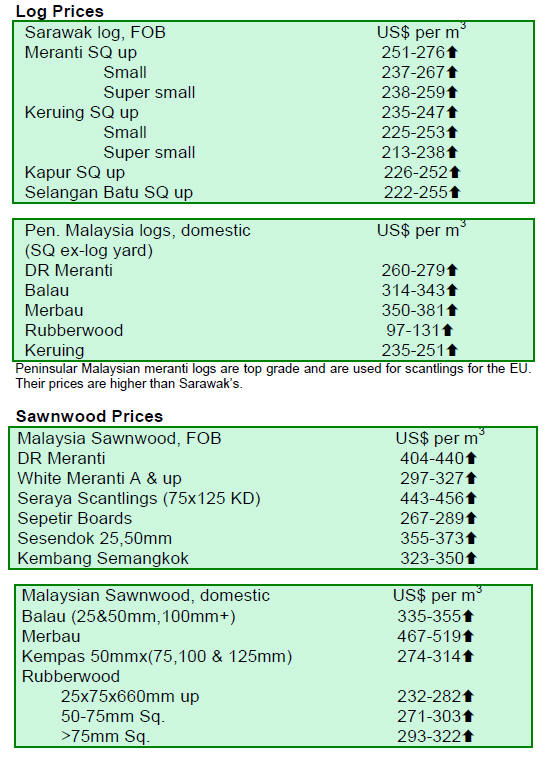
4.
INDONESIA
Indonesia ready for the VPA
The Indonesian government is ready to sign the Forest
Law Enforcement, Governance and Trade - Voluntary
Partnership Agreement (FLEGT-VPA), with the European
Union (EU) within the next two to three months,
according to a joint statement.
The Indonesian government noted that the VPA will be
the
first of its kind to be signed between an Asian country and
the EU, with a significant implication for the US$1 billion
annual timber trade between these two parties.
Disagreements hamper establishing legal framework
for moratorium
Last year, the Indonesian president signed an agreement
with the Norwegian government the purpose of which is to
halt deforestation. One of the first steps Indonesia took on
signing was to impose a moratorium on forest conversions
from 2011 to 2013.
However, disagreements between the Forestry Ministry
and the newly established Presidential Taskforce on
reducing deforestation and forest degradation (REDD)
programmes has hampered the government’s efforts to
implement a legal framework for the moratorium.
It appears that there are differences of opinion on
which
forests should be included in the moratorium and whether
the new Taskforce should be given authority to oversee
forest management — traditionally the domain of the
Forestry Ministry.
Tropical Forests Conservation Act Agreement between
Indonesia and US
Indonesia and the US have signed a Tropical Forests
Conservation Act Agreement which includes a grant to
improve forest management and protect biodiversity in
Sumatra.
The agreement is said to be an important part of the
USIndonesia
Comprehensive Partnership. The US$30 million
grant will help to improve management of 1.3 million
hectares of peatland and forests over a three year period.

5.
MYANMAR
Improvement in demand situation
The market situation for teak and other hardwoods has
been improving. As a result, prices at the Myanmar Timber
Enterprise (MTE) tender sales are buoyant. Demand for
teak remains good especially for SG-7 (Sawing Grade-7)
logs.
While demand for pyinkadoe did not show much
improvement over the past months, the kayin market was
buoyant following the steep decline seen in mid 2010. It is
reported that even some old logs are being sought for
export. According to analysts, the supply of logs from
Northern Myanmar is tight as river levels are low
hampering log transportation by rafts.
Furniture exports drop
According to the Myanmar Timber Merchants
Association, exports of furniture have dropped by about
70% to 40 - 60 containers a month.
The export of value-added products from Myanmar is very
small compared to log exports. Furniture for export is
made from teak and sagawa (Michelia champaca) and
yemane (Gmelina arborea). Rattan furniture is also
produced and exported.

6. INDIA
MOU to expand Sandalwood forest area
in Karnataka
The state of Karnataka is the largest producer of
sandalwood (Santalum album) in India. However, as a
result of illegal logging and smuggling, sandalwood in
natural forests is under threat of extinction and imports
from other tropical countries are needed to meet the
demand in India.
In order to revive the state’s sandalwood
production, the
Forest Department, local industries and farmers have
entered into a MOU to expand the area for sandalwood
production to 2,000 acres in the state of Karnataka. In
addition, the state government has removed the 50% tax
on profits from sandalwood production.
Trade of non-wood materials
Paper laminates
As a result of reduced supply of premium quality logs
from natural forests, coupled with environmental concerns
and promotion of non-wood products by government
departments, demand and thus production capacities for
manufacture of paper laminates, metals and plastics for
furniture manufacturing and joinery has grown. However,
Indian manufactures of these non-wood materials are
facing increasing competition from imports from China.
Particleboard
The estimated production of particleboard in India is
around 150,000 tonnes per year. Shortages of raw material
and improved market acceptance of Medium Density
Fibreboard (MDF) has slowed the growth of investment in
particleboard production in the country.
Several interior joinery firms have begun to use
boards
made of agricultural waste to manufacture doors and
furniture. However, the domestic supply of particleboard
falls short of demand and this has raised the need to
increase imports from Australia, Malaysia and Europe.
MDF
Indian MDF production capacity had tripled in four years
to 310,000 cu.m per year by 2010 and new plant is under
construction. However, China’s MDF production capacity
is reportedly 30 times that of India’s. As a result, Indian
manufacturers are facing stiff competition from China. In
order to compete and maintain profitability Indian MDF
manufacturers have focused on production of value-added
products.
Laminated flooring
The domestic market for laminated flooring has been
growing fast. New designs and concepts are being
imported from around the world to the Indian market. For
example, Southern European manufacturers have
introduced new paper-free laminated flooring with a slate
stone surface.
Plywood manufacturers importing more core veneers
The Indian plywood industry is continuously facing
shortages of logs and skilled labour, coupled with rising
costs of chemicals. In order to cope with the raw material
shortage, plywood manufacturers have been importing
more core veneers.
Around the world, plywood prices have been trending
upwards. Prices of imported plywood have been
increasing in India.
Imported teak prices steady
Demand for imported teak continues to be good and prices
vary depending on quality. However, a lack of containers
in some exporting ports limits shipping.
According to an analyst, the quality of plantation
teak logs
imported from West Africa is dropping. However, due to
the log shortage and lower imports from Myanmar, prices
have remained stable.
For example, teak supplied from Tanzania is from old
plantations, some of them reaching 80 years old. The
colour of heartwood is good with some occasional black
stripes. However, the major defect inr Tanzanian teak is
that it has many knots and thus good quality logs are only
available in short lengths.
The Indian market buys Tanzanian plantation teak
mostly
for door frames with lengths of 7" / 7 1/2". Even shorter
lengths are sourced for window frames and furniture.
Besides length, good color is the major determinant in
sales of teak for doors, windows and furniture. Tanzanian
plantation teak imports to India include sawnwood, but the
majority are boules due to the lower import duty imposed
by India. Boules are assessed in India for duty as round
logs.
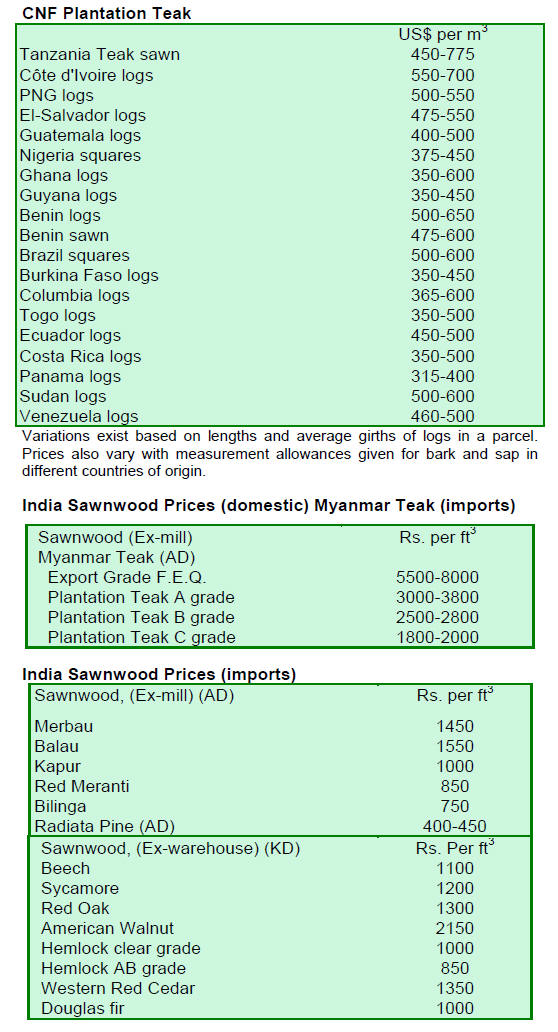
7. BRAZIL
Deforestation rate declines in
Amazon
The National Institute for Space Research (INPE) Real
Time Deforestation Detection System (DETER) released
information showing that between August 2010 and
February 2011, the deforestation rate in the Amazon
declined 7.1% compared to the same period in 2009 and
2010.
Other data shows that in 2010 deforestation was
reduced
in the 43 priority municipalities combating deforestation.
In 36 municipalities in the Amazon identified as major
deforesters in 2008, the current deforestation rate has been
reduced by 29%.
According to the Brazilian Ministry of Environment
(MMA), Querencia municipality in the state of Mato
Grosso will be deleted from the list of major deforesters in
the Amazon. Paragominas, in the state of Para, was the
first municipality to be removed from the list, in 2010. In
both municipalities, the average deforestation rate over the
past two years was equal to or less than 60% compared to
the average between 2005 and 2008.
In the same period, DETER shows that deforestation
rate
in the states of Roraima and Mato Grosso declined 77%.
However, in other states, such as Acre, Amazonas and
Tocantins, deforestation increased and by as much as
181%, in the case of Acre.
In the coming weeks, MMA expects to hold a meeting
with state governments to discuss deforestation rates and
to critically assess why the deforestation, that previously
occurred only during dry season, is now also occurring in
the rainy season.
SFB Promotes Education for forest Management
The Brazilian Forest Service (SFB) and other institutions
will launch an “Education for Sustainable Forest
Management” project to deliver information and provide
training on the importance of forest management. The
objective is to increase the number of skilled professionals
in the Amazon able to conduct sustainable logging.
The demand for skilled professionals is currently
high and
growing especially for those operating forest concessions
in national forests and for community forest management
operations. There are over 1 million hectares of forest
concessions at different stages of implementation in the
Amazon, but this could rise to 10 million hectares in the
coming years. It is estimated that, in the short term, at least
10,000 trained/skilled workers will be needed for these
operations.
The SFB will use distance education methods as well
as
field training. The expected benefits include an
improvement in worker safety, more efficient sustainable
harvesting and an overall increase in the returns from
forest activities in the Amazon.
March trade figure released, timber exports
decline
In March 2011, the value of exports of timber products
(except pulp and paper) fell 3.6% compared to values in
March 2010, from US$ 225 million to US$ 217 million.
Pine sawnwood exports increased 15.7% in value in
March 2011 compared to March 2010, from US$ 13.4
million to US$ 15.5 million. In terms of volume, exports
increased 7.2% from 62,400cu.m in March 2010 to 66,900
cu.m in March 2011.
Exports of tropical sawnwood fell both in volume
and in
value, i.e. from 50,800 cu.m in March 2010 to 35,100
cu.m in March 2011 and from US$ 25 million to US$ 19.3
million, over the same period.
Pine plywood exports also fell, dropping 7.3% in
value in
March 2011 compared to the same month in 2010, from
US$ 32.8 million to US$ 30.4 million. The volume of
exports also dropped 15% during the same period, from
98,200 cu.m to 83,500 cu.m.
March 2011 exports of tropical plywood fell to
6,900 cu.m
down from 9,500 cu.m in March 2010, a 27.4% decline. In
value terms, a 29.3% decline was recorded, from US$ 5.8
million to US$ 4.1 million.
Exports of wooden furniture also dropped. Export
values
dropped from US$ 55.2 million in March 2010 to US$
43.4 million in March 2011, representing a 21.4% drop.
Brazil’s economic situation favors timber
imports
Brazil’s annual timber imports average around US$ 120 to
US$ 140 million per year. The United States is the major
supplier and most business is supported by the American
Hardwood Export Council (AHEC).
The economic situation in Brazil, the sustained
appreciation of the Brazilian currency and the staggering
increase in the domestic timber demand is driving imports.
Additionally, weaknesses in domestic timber production
systems and product quality are said to be factors favoring
timber imports in Brazil.
Computerised timber identification system
Work on timber identification considering environmental
and tax issues is conducted by the Institute of Agricultural
Protection of the State of Mato Grosso (INDEA-MT), the
Renewable Natural Resources Control (CFRNR) Unit. The
timber identification tools developed by CFRNR have
been in interest of other states seeking to develop their
own systems, including the state of Para.
Since January 2011, the Computerized Timber Control
System (SICMAD) has been operational at the INDEA's
timber identification check points. This tool is used to
monitor, audit and control Timber Identification
Certificates issued by the INDEA Local Units. These units
assist to develop activities for timber identification,
improved forest control and preventing tax evasion in the
state.
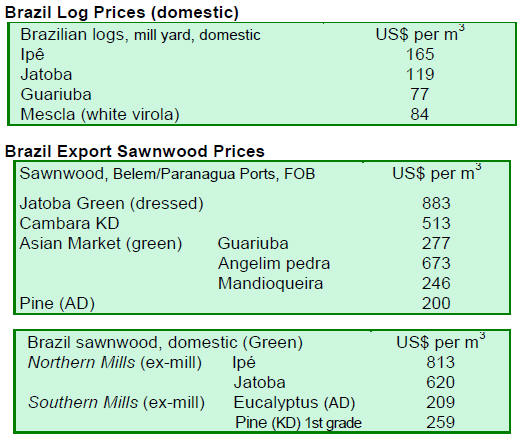
8. PERU
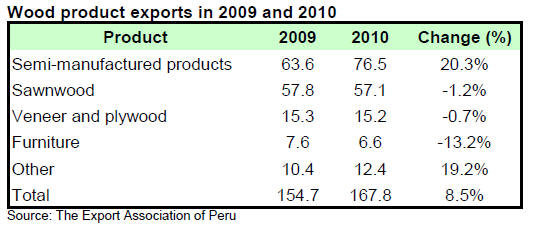
Promoting new species for furniture
manufacturing
The Ministry of Production of Peru is promoting the use of
64 lesser used timber species for furniture manufacturing.
The executive director of the Center for Technological
Innovation Wood (Cite Maderas), Jessica Moscoso, said
that this initiative seeks to ease the intensive use of
mahogany and cedar by introducing alternatives with
similar qualities.
Peru domestic furniture sales are forecast to grow
10% this
year compared to 2010, driven by demand or office
furniture and by shopping centres.
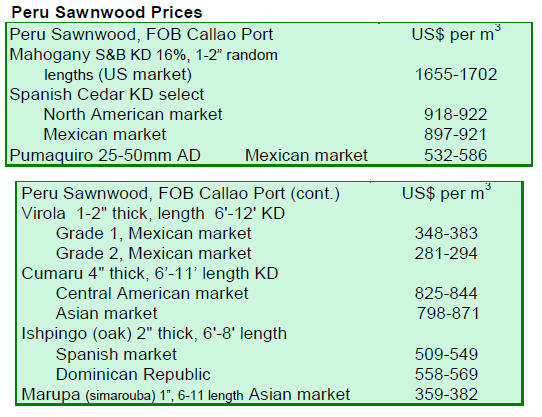

9.
GUYANA
Price trends
In early April there were no exports of Greenheart logs.
Export prices for all categories of purpleheart and mora
logs increased. Some of Guyana’s lesser used species were
also exported in log form fetching good average prices.
Un-dressed Greenheart (select) sawnwood prices
improved towards US$730 to US$975 per cu.m. but
prices for un-dressed purpleheart declined. On the other
hand prices for Dressed Greenheart dropped from US$
1,350 to US$ 1,011 per cu.m. Prices for un-dressed Mora
sawnwood were generally maintained.
The export of piles and poles made a noteworthy
contribution towards the export earnings, for these
products the major market is North America.
Guyana’s Ipe (Washiba) continues to attract
significant
top-end prices reaching as high as US$ 2,250 per cu.m.
Wallaba splitwood is in good demand and export
earnings
from this product were significant.
Many of Guyana’s lesser used species were exported
for
the production of sawn construction timbers as these
woods have very good structural properties. Europe was
the major destination for these sustainable and durable
Guyanese timber species.
Guyana‘s Plywood factory to restart operations
Guyana’s single plywood manufacturing company Barama
is aiming to restart its plywood operations as soon as June
of this year and hopes to have export products ready for
shipment in December.
Domestic demand for plywood is strong and the
reopening
of this mill will ensure that that the development of the
domestic housing sector is not held back. The plywood
factory is looking to achieve a production rate in excess of
2,400 cu.m. per month.
The company is also engaged in the production of
veneers
to further compliment the plywood factory. The plywood
company is providing employment to a significant number
of workers within the forest industry. The re-opened
factory will reduce the shortages of panels faced by
contractors and builders.
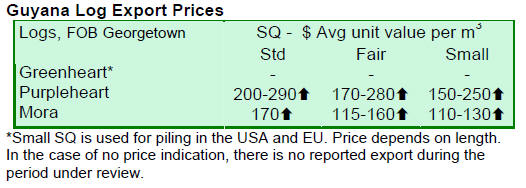
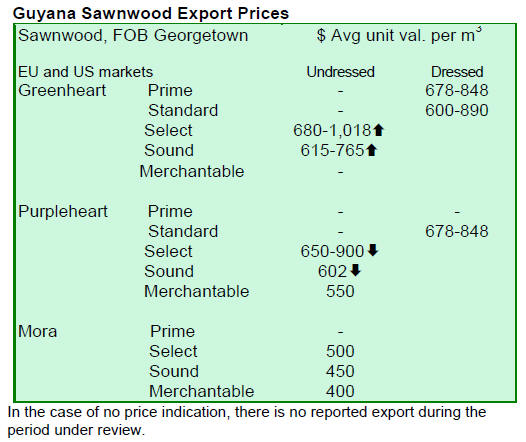
10.
BOLIVIA
CITES Plants Committee to classify Big Leaf
Mahogany as a "species of urgent concern"
A CITES Plants Committee meeting was recently held in
Switzerland and there are unconfirmed reports that Bolivia
was advised to set zero harvesting quota for Big leaf
Mahogany (Swietenia macrophylla)
Bolivia did not submit a non-detriment findings
report for
Big Leaf Mahogany and this triggered the Plants
Committee to classify Big Leaf Mahogany as a "species of
urgent concern" and to recommend that within three
months Bolivia should set a zero quota.
This information is not yet on the CITES website
but
importers are advised to follow developments as it may
take some time for Bolivia to re-validate its non-detriment
process.
Related News: